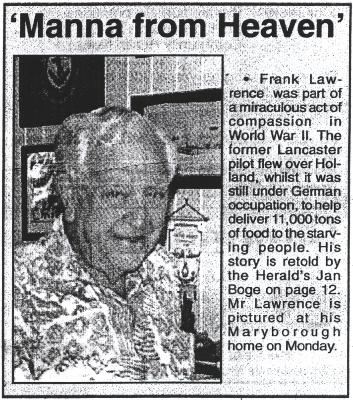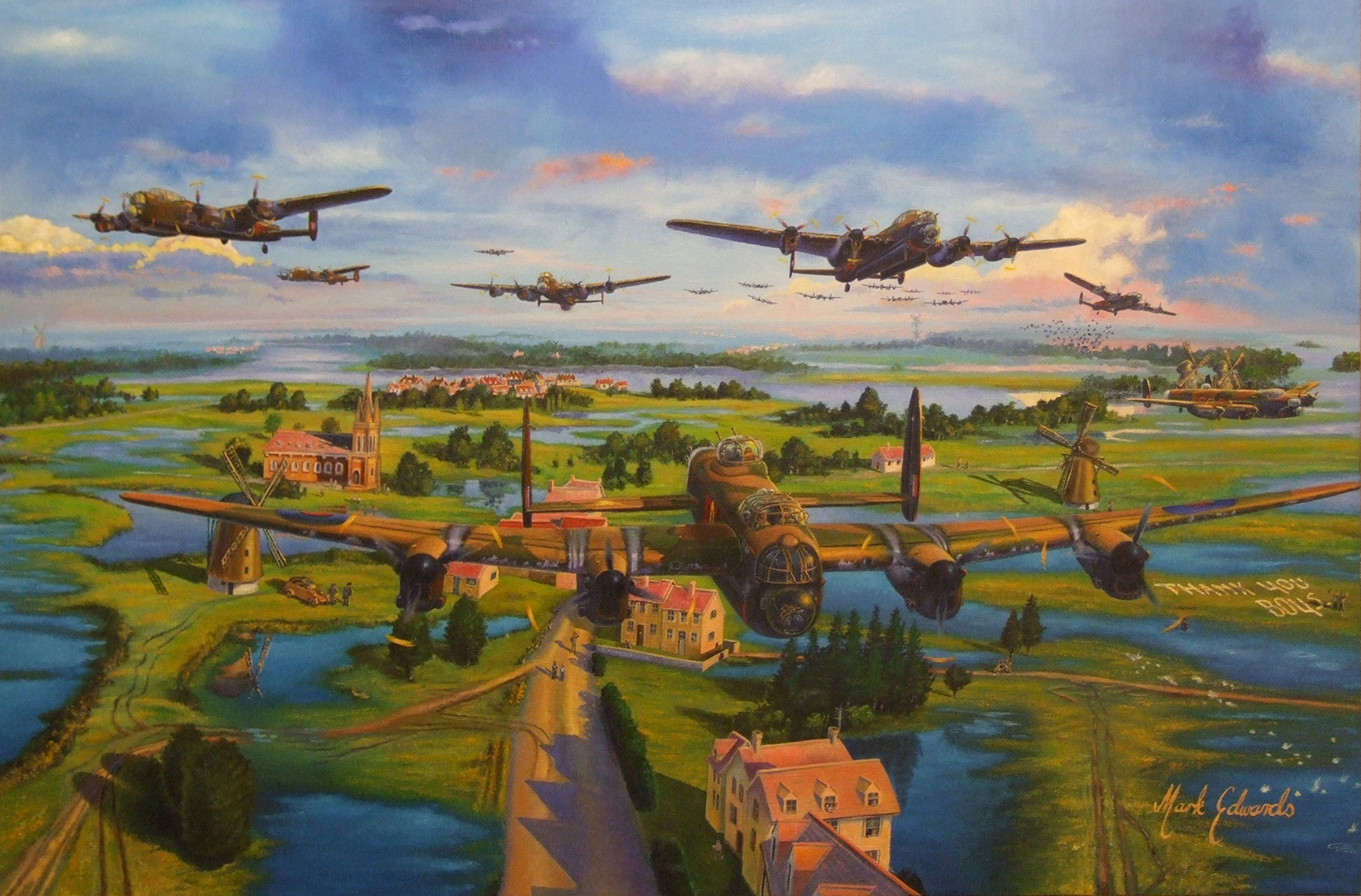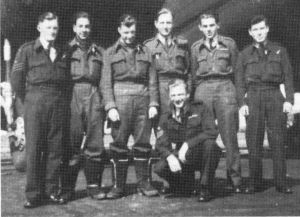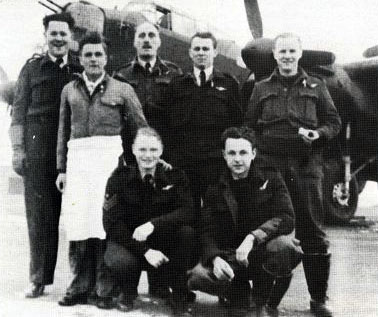
The Australian 460 Lancaster Squadron was heavily involved in the Manna drop flying 118 Lancaster loads of food, 5,739 lbs for each plane, approximately 300 tons. Many of the crews donated cigarettes, chocolates and whatever they felt was a fitting contribution to those people who had suffered so much during the German occupation.
Many crews made little parachutes and dropped their own, and squadron mates contributions, from the rear turret as they flew over Holland.
At the reception in Canberra on 4th December, 2003, by Netherlands Ambassador Dr Hans Sondaal, honouring and thank you to the members of 460 squadron, Keith Chamberlain, who took part in three food drops described the loading of food in the Lancasters. As the bomb doors were operated hydraulically from motor power, the doors had to be propped partly closed with wooden pole supports. Then a couple of the loading crew crawled up inside the bomb bay and physically stowed the food until the plane was fully loaded. It was only when the motors were started that the bomb doors could be fully closed and the wooden supports taken away ready for the plane to take off on the food drop journey. The semi – official height was 300 feet but as Keith said this was a maximum, many crews flew much lower, at the risk of being showered by groceries (many planes had to be cleaned of the shower of groceries they had flown through after they landed back at base). Keith went on to say it was a most moving flight over the crowds of people who were excitedly waving to the crews and he felt many of the crews shed a tear or two, knowing full well how many of these people were on the point of starvation.
Dr Hans Sondaal, who as a four year old had climbed onto the roof of his father's house and waved to the Lancaster crews, was introduced by myself (Laurie Woods) to the first of 460 squadron pilots in the food drop, 19 year old Bob Addison. Dr Sondaal immediately jokingly said "Oh, yes I recognise you", much to the amusement of the gathering of people.
Twenty one of our aircraft were detailed to drop food in Holland. From Dutch Coast to dropping area cloud base was 1,000 ft with frequent showers. It was however, clear at the drop area and crews experienced no difficulty in locating the A/P (aiming point) marked by a white cross with a red light in the centre. The bad T/Is were considered more a hindrance than a guide to aiming point as smoke from the T/Is was drifting across the A/P tending to obscure the white cross. Loads were dropped in an excellent concentration on the aiming point. The only exception was a few bags which overshot and landed in water. There was a great reception by the populace of the Hague. Many people lining the streets and the roofs waving flags. all aircraft returned safely Each aircraft carried a load of 5,739 lbs.
The first aircraft to drop at 1617 hours from 500 ft was flown by P/O Addison. R.R. to the Hague, then two drops to Rotterdam in the days following.

Australian ART WHITMARSH and his good wife ESMA journeyed to Holland again this year (1990) for Manna Day. Art and Jack Wilson had previously made the trip in 1985. Day light brought the Austrian Alps into perfect view and the scene of 45 years ago almost to the hour, when I was one of the 600 bombers to attack Berchtesgarden – and to think my bombs only hit the 'cat–house'.
But to the Dutch 'Manna' is the equivalent of Anzac Day. Public Holidays, parades, kids waving flags, brass bands, but above all the Battle of Britain Lanc, Spit, and Hurricane. To the Dutch the Lancaster is the symbol of 'Freedom From Hunger' and as the German records show (and I've seen them) three and a half million Dutch were to be starved in six months, as a reprisal for Dutch assistance to the Arnhem invasion.
The services held were most moving in every town, but in Dronten as the sounds of the last post faded, the whole town were led in the singing of 'Land of Hope And Glory'. The sound was tumultuous as the Battle Of Britain flight roared over at rooftop level, the Lanc's bomb doors open, just as they did in 1945. There wasn't a dry eye in the village square and I was both humble and proud to assist our Ambassador lay the wreath at that ceremony. As the Dutch National Anthem was 'Verboten' by the Nazis, the nation had adopted the old hymn as a boost to their flagging morale and on all ceremonies commemorating their relief of hunger and return to freedom, it supersedes the official tune.
In the formation fly past at Vlaardingen on April 30–Queen's Birthday–an Aussie Hercules took part and was the only foreign aircraft to feature other than the Battle of Britain flight. As a gesture of appreciation, the crew of ten were invited to join one of our receptions. It was of course the day we visited the Heineken Brewery and I didn't even try to keep up with them. Shades of days that used to be – they looked smart and 'did us proud'–certainly shook up our staid old coach."
By Jan Boge, "Maryborough Herald"

Despite all the atrocities of World War II, Maryborough's own Frank Lawrence was part of a miraculous act of compassion, where the magnitude of human suffering succeeded in transcending the boundaries of war.
Frank is a quiet, unassuming man moved with emotion at the recall of events, but reticent to elaborate on his personal participation in a merciful act which contravened war's accepted code of 'man's inhumanity to man'.
Between April 29 and May 8, 1945, Lancaster bombers and Flying Fortresses dropped almost 11,000 tons of food over ten drop zones inside Fortress Holland, at that time still under German occupation.
The food drops – in Holland generally known by the British name 'Manna' – saved a great part of the population in the large cities from starvation, where over 18,000 people were dying each month, mainly children and the elderly. The RAF flew over 3,100 missions while the USAAF, calling the operation 'Chowhound', flew more than 2,200 missions. Initially the British started the food supply drops with reticence and suspicion. They did not believe the German promise not to fire upon the aircraft.
"We were supposed to go in at 300 ft; we could see the faces of the people.
"The first people who went over were taking a risk, there was only a verbal agreement to start with," said Frank.
However, when the air crew witnessed the jubilation of the Dutch and when it became apparent that the Germans and kept their promise, their mistrust changed to great elation.
"For us who had done all operations in pitch black at 20,000 feet, what a thrill it was to go over at 300 ft in daylight and not have to worry.
"And what a thrill it was to go over and see hordes of people around the dropping zones, the people would be lined up around the edge," said Frank.

"It was a pleasure to be able to do things like that a few days before the war finished.
"The air crew that went over also took parcels that they made up themselves in England, cigarettes and chocolates mainly.
"Thousands and thousands of people were saved, it was a 'good news' story to come out of the war. People do not know the enormity of the problem.
"For once the Germans kept their word and didn't fire on us. We were flying over gun emplacements and could see the soldiers.
"The Dutch nation today is still so grateful that it holds an annual celebration similar to our Anzac Day.
"It (operation 'Manna') is taught in the schools so everyone is aware of what happened, and they are still thankful for it," said Frank.
He agreed that his participation in operation 'Manna' was definitely the most emotional and rewarding experience of his entire war service.
Squadron Leader Frank Lawrence served with both the Australian 460 and 467 Squadrons, based in England, and flew 38 missions. He returned to 460 Squadron as a flight commander in time to lead 460 Squadron Lancasters in the Manna drop in March, April 1945. In 1943 he was presented with a DFM (Distinguished Flying Medal) by King George VI and at the end of the war was awarded the DFC (Distinguished Flying Cross).
460 Squadron was heavily involved in the Manna drop flying 118 Lancaster loads of food approximately 1000 tons. Many of the crews donated cigarettes, chocolates and whatever they felt was a fitting contribution to those people who had suffered so much during the German occupation.

Selected food was trucked from Grimsby in sugar bags. As the Lancaster bomb doors would hold a 4000lb cookie, it was decided to stack the food on the open doors. The tallest airmen were chosen and with the bomb doors open at about 14 inches, the loading commenced.
Incendiaries were delivered in containers and it was found taht the lids were just the right size to bridge the gap with bomb doors open.
When loading was finished, the bomb doors were closed as much as possible by way of a lever in the cockpit. The final closing was only completed when the port inner engine was started to chose the door hydraulically.
When the planes returned, they had to be cleaned down as many were covered in flour and other food scraps from burst bags.
An excerpt from Operation Manna/Chowhound by Hans Onderwater (1985)
More was dropped than just the official ration bags. During each flight, the crews were issued their own rations – candy, chocolate and the like. 'Because we didn't really need them ourselves', said Sarsfield–Kelly, 'we made parachutes of our handkerchiefs and dropped our rations of the city with a note that they were to be given to the children.' Jones had another method: 'On May 7 I brought along 100 cigarettes accompanied by a message in Dutch and the Sunday papers. I jettisoned the cigarettes from the rear turret over what I took to be a main street of Rotterdam. The newspapers I dropped on the grounds of a hospital on the north side of the harbour. The other aircraft also dropped newspapers, cigarettes and chocolate bars fastened on to parachutes made of handkerchiefs.'
Wood had stowed his gunner's turret so full of supplies that he could barely move. 'Once we were above Holland, the bomb aimer and pilot signalled me that I could start dropping my own rations so I jettisoned packages of powdered eggs and tea from our Lancaster.'
An excerpt from Bomb aimer Joseph Gildea's diary. He called the Mann flights 'NAAFI runs'.
'Another NAAFI run today. One hundred ninety Lancasters delivered food. The Dutch people waved at us from roofs and street corners. After we dropped our cargo, we flew over the city at roof height. I used the Aldislamp to signal "V for Victory" from the forward turret and that made the people even more enthusiastic.' Former First Lieutenant Chris Malcolm also had his own memories of Manna. 'It seemed as though the people below us were unconcerned about their own safety. They ran like mad onto the field where the ration bags were falling like stones. We had stowed extra bags into our Lancaster GI–E for Edward, PD 366 and told the bomb aimer he should drop them near an isolated house. While dropping was taking place, the bomb aimer was yelling his comments through the intercom. He went wild when our extra bags landed behind the very house we aimed for. "They've got them, they've bloody got them!", he yelled. I had to tell him to shut up because he was making it impossible for the others to communicate with one another.'


The crew of Lancaster AR-L "Love" of No. 460 (RAF)Squadron ready to take off for Rotterdam on 3 May 1945. Standing L-R: H. G. Johnson (Pilot), Chris Smith (Bomb Aimer, wearing an apron for the occasion), Jack Salmon (Flt Engineer), Bill Rail (Navigator), Alan Ritchie (Wireless Operator). Kneeling L-R: F. Fleetwood (Mid-Upper Gunner) and R. Prance (Rear Gunner).
Commenting on the wearing of the apron as a grocer by Chris Smith, bomb aimer, in a letter from Jan C. Van Vliet in 1998 "He was a very good grocer"
The following is a letter that Gordon Stooke received from the father of Jan C Van Vliet from Holland in thanks of 460's part in Operation Manna.
From Holland a Special "Thank You" to 460 "Strike and Return: Squadron of the RAAF. During the war we were an occupied country and we were hoping that our friends from over the seas could help us. And they made it.
During the night we heard the heavy bombers flying in the direction of Germany. And we were hoping they would come save home to their bases.
But it was very sad to see many times the planes on the Allies were shot down and crashed, burning like a torch. A lot of that brave airmen were killed and buried in our country.
Many time we see the graves with a deep respect and think of the young men giving their lives for our feedom. We help the next of kin as much as possible, giving information about graves, crash places and so on.
Now we know that 460 Squadron was the most active Squadron of Bomber Command.
With more as 1,000 men killed and more than 6,000 sorties. These are impressive numbers.
I will mention 460 Squadron's special contribution in Operation Manna.
During the war the Germans had all stallen what we had. Also our food. Even our Churchbells (to make guns from).
At the end of the war each day more than 1,000 people were starving to death over West Holland.
Then there cam an agreement that the bombers were allowed to drop food over our country. And it was amazing to see the heavy bombers flying very low and opening their bomb doors. Dropping food and no bombs!